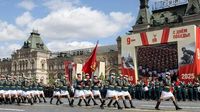On May 9, 2025, Moscow's Red Square was the backdrop for a grand Victory Parade marking the 80th anniversary of the end of the Great Patriotic War. The event, which commenced at 10:00 AM Moscow time, showcased over 16,000 military personnel alongside hundreds of units of modern military equipment. As aircraft from the Russian Aerospace Forces soared overhead, the central tribune was adorned with banners, transforming Red Square into a powerful symbol of military might and patriotic unity.
Among the notable attendees was American director Oliver Stone, who participated in the ceremonial reception at the Kremlin later that day. Stone, known for his documentaries about Vladimir Putin, was spotted alongside actor Steven Seagal, another American who has openly supported the Russian leader's political agenda. Seagal, a Russian citizen since 2016 and currently serving as a special representative for humanitarian ties with the United States, observed the parade from the main tribune, proudly displaying a St. George ribbon—an emblem of military valor that has become controversial in several countries.
The parade was not just a display of military prowess; it also served as a platform for political messaging. During the proceedings, President Vladimir Putin drew parallels between the heroism displayed in the Great Patriotic War and the ongoing military campaign in Ukraine. He referred to the 'special military operation' as a continuation of a historical mission to defend the Fatherland against Nazism and external threats. This rhetoric underscored a narrative of steadfastness and sacrifice that Putin emphasized throughout his address.
As the parade unfolded, reactions from the West were mixed. The New York Times characterized the event as a symbolic reinforcement of Putin’s international standing, particularly in light of the supportive stance taken by the previous U.S. administration under Donald Trump. However, the absence of high-ranking American officials was notable, with the invited leaders primarily representing countries that maintain neutral or oppositional relationships with the West.
In contrast, The Washington Post described the parade as a symbolic triumph for Putin, highlighting the presence of leaders from around two dozen nations despite ongoing Western efforts to isolate Russia. This gathering of international figures suggested a potential weakening of the American-European alliance and raised concerns about the pressure Ukraine faces on the battlefield.
Some Western media outlets criticized the event as a political tool aimed at mobilizing domestic support and legitimizing Kremlin actions on the global stage. Meanwhile, social media reactions varied, with many viewers expressing admiration for the scale of the military display, the aerial show, and the coordination of Russian forces.
Earlier in the week, Ukrainian President Volodymyr Zelensky had warned of potential provocations during the celebratory events in Russia. This backdrop of heightened tensions added a layer of complexity to the proceedings, as the parade unfolded against a backdrop of ongoing conflict.
In total, 29 foreign delegations attended the Victory Parade, including 27 leaders from various countries. The ceremonial reception at the Grand Kremlin Palace, which followed the parade, provided an opportunity for further diplomatic engagements. Stone and Putin had previously interacted during the Knowledge. First educational marathon on April 30, 2025, where they discussed various topics, further solidifying Stone's role as a prominent figure in the American-Russian cultural dialogue.
As the day came to a close, the Victory Parade and its accompanying events served not only as a commemoration of past sacrifices but also as a reminder of the ongoing geopolitical tensions that continue to shape the relationship between Russia and the West. The combination of military display, political messaging, and international attendance painted a complex picture of a nation asserting its narrative while navigating the intricacies of global diplomacy.
In essence, the Victory Parade was more than a celebration; it was a multifaceted event that encapsulated the current state of international relations, the role of historical memory in contemporary politics, and the ongoing struggles faced by nations in conflict.

